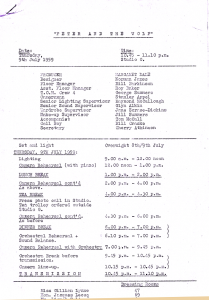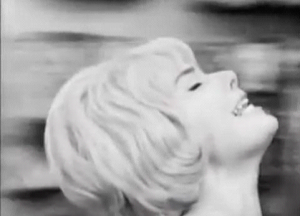Brian White
Stan Appel’s “Peter And The Wolf” – all on one shot!!
Stanley Appel
I have found the script of “Peter and the Wolf”! It is about the only script that I ever saved! I am including the front page. I hope someone has a crew list and perhaps someone out there remembers who my helpers were! I see it was live and that the shot lasted 25 minutes!
Peter Booth
"Oedipus" with Basil Coleman directing.
EVERY shot, bar one, was a static frame – the exception being when Oedipus realised what he had done and the camera panned from a BCU of the shepherd who had raised him to an even closer shot of his, Oedipus, eyes – in anticipation of the act of him blinding himself.
John Howell
On Jean Anouilh’s "Point Of Departure" in R1, 13th-15th December 1964, Peter Ware had a shot that lasted the whole 1st act (some 15 Minutes) and he tracked back with the artist lit by two camera headlights until he was opposite the hotel room and panned into the set for Act 2. I seem to remember the lighting change didn’t happen correctly and we had to stop, better not mention the Lighting Supervisor.
It was a dream for boom ops, one shot on a fixed 24 degree lens!
Geoff Fletcher
I was bashing Pete’s cable on that shot and marvelled at the time he seemed to have to work his ped, check and turn his shot cards, and even somehow keep his tiller steer handle in the right place for crabbing. I have always considered Pete to be the best ped man I ever saw anywhere, and that includes the rightly famed Jim Atkinson of Crew 5. All Pete’s ped work seemed so effortless. My guess was that flying Spitfires and Hurricanes in WW2 had given him an edge in physical co-ordination and sense of timing.
From my 1964 Diary
December 15
R1: Point of Departure 1200 – 2230
Cables
Pete did an amazing shot – a whole act on his own.
Continuous 15 mins or so development on a ped,
including tracking actor from one set to another lit
only by his camera lamps!
John Barlow
To my mind, for what it’s worth, the prize goes to Jim for his 30 minute “the camera is the artiste” shot on “The Seventh Juror”. When the juror sat down Jim didn’t just depress the ped he gave a little tilt down and up to reflect and mimic the action a real person actually takes. I was cabling bashing on this one and recall him, at about 20 mins into the shot, crabbing past a laden hat-stand so close that for an instant the frame was black. He explained that he thought it necessary to create an edit point in case the cast made a mistake just before the end and he didn’t want to redo the whole shot.
Rodney Taylor’s “Diary of Ann Frank” was shot with almost all static frames – a superb piece of stylised work.
Clive Doig
My meagre offering is only from the perspective of a VM’s ease of working during the developing camera shot period. Cut to the camera and sit there and watch the lot. Occasionally fade out or mix, and sometimes cut. Easiest vision-mixing duties of all.
My example of the extreme of this TV technique, in deference to all the Pete and Stan and Jim ped achievements, is the 1965 production of Giles Cooper’s “Unman, Wittering, and Zygo”, which may have had Jim on the main camera.
Donald McWhinnie directed, as he did all Giles Cooper TV plays, and he was a great proponent of single camera developing shots, especially in this 90 minute drama.
Although there were over 150 shots in the camera script, only five of them took up 85 minutes of the play! The remaining 145 shots were all in two manic, hectic scenes which were both roll calls in the same school classroom, (hence “Unman, Wittering, and Zygo”) I think Hywel Bennett and Denis Waterman were two of the boys.
There was one 20 minute shot just prior to the first roll call, and I had probably nodded off (more about that later), and then three pages of script with 75 shots on it, Teacher, boy, Teacher, next boy, etc. and interruptions, all big close-ups. More lines across the script than dialogue. By Jove! That woke me up, (but not Donald) and the PA and the other four cameras, as we cut at nearly 30 shots a minute. The mayhem finished and Donald had scripted back to a ten minute developing shot again, and a couple of cuts in the next half hour before another manic roll call scene.
During the whole recording, which we achieved in one take, Donald, who had had his fair share of gins and tonic, was apparently asleep next to me, and only woke up as we rolled the roller, and said in his languorous tones, “How did that go?” and we all replied “Brilliantly!” at which he responded, “I knew it would. Thanks everybody, to the bar!”
Donald was a wonderful director of few words who planned and rehearsed to perfection and did not need to say anything during the recording, as everything worked out as he had wished it to. I believe the greatest. What did that group of directors call themselves who directed all those developing-shot plays, was it “the ’59 Group”?
David Brunt, Derek Needs
27.06.1965
Theatre 625: “Unman, Wittering, and Zygo”Written by Giles Cooper; story editor James Brabazon; designed by Austen Spriggs; produced by Cedric Messina; directed by Donald McWhinnie.Duration: 70 minutes.
With
Peter Blythe (John Ebony),
John Sharp (Cary Farthingale),
Tamara Hinchco (Nadia),
Peter Howell (Headmaster),
Noel Davis (Mr Winstanley),
Ann Way (Mrs Winstanley),
Norman Wynne (Inspector),
Jeremy Ranchev (Aggeridge),
Roger Shepherd (Ankerton),
Robert Dodson (Borby),
Roger Bradley (Bungabine),
Michael Wennink (Cloistermouth),
Christopher Witty (Cuthbun),
Dane Howell (Hogg),
Hywel Bennett (Lipstrob),
Norman Bacon (Mudd),
David Pusey (Muffet),
Brian Godfrey (Munn Major),
Hugh Janes (Orris),
Michael Sarson (Root),
Dennis Waterman (Terhew),
Nicholas Young (Trindle),
Jonathan Collins (Unman),
Patrick Heigham
Mervyn Pinfield made excellent use of a five-camera studio by using one camera per set – so all coverage of a single set was with tracking/zooming/panning on one shot.
Jim Atkinson (Crew 2) taught me camera operation in 30mins! I subsequently went on the sound ladder – funny that!
I loved the Albert Hall prom with the first broadcast of the John Wilson Orchestra, the MGM Celebration one. I learned that there were 1500 cuts in 120 mins. This is available as a commercial DVD, so you can get it and count them!
And the sound! The PA is reported as saying that when at rehearsal for the first time, hearing it live, it was ‘hair-on-the-back-of-the-neck raising’!
In movies, with “Russian Ark”, director Alexander Sokurov actually made a 96-minute historical drama using a single Steadicam shot.
Roger Bunce
Alfred Hitchcock did it first, of course, with "Rope". Filmed so that it appeared to be a single, continuous shot, with actors wiping frame at key moments so that they could change film rolls.
Graeme Wall
I remember doing inlay for a drama sometime around 1975 in TC1. The opening shot was around 10 minutes on Camera 1. Come the take the VM, whose initials may have been CD, mixed from the titles to shot 1 then got out of his seat and walked out through the lighting gallery. This left the director, PA and TM2 staring at the door wondering what was going on. Meanwhile the shot continued on its way till, at the appropriate moment, the VM walked in through the other door, sat down and cut right on cue.
Hugh Sheppard
Once upon a time, one of John McGrath’s early “Z-Cars” – as well as the first one – featured in a ditty by John Adcock and me, which was strummed, sung and recorded by James Ellis, and included the line: John "six-hundred shot McGrath". No, I don’t remember much else about it, but in a live 50 minutes of Z’s it’s unlikely that anyone else came close.
Dave Buckley
In the early 1970s TV Theatre (TVT) took delivery of a couple of IVC 1" VTRs. While testing them, we asked CAR for a feed of something interesting to record.
They offered the rehearsal of an episode of the Six Wives of Henry VIII. While watching, there was a sequence where there were 18 cuts in something like 15 seconds! We recorded the sequence and played it back to check the cutting and timing.
In Camera
Alec Bray, Geoff Fletcher, Bernie Newnham
“In Camera” was produced by the BBC in 1964, adapted for television and directed by Philip Saville, starring Harold Pinter as Garcin.
Alec and Geoff looked in the studio (TC3) during rehearsals.
There were three or four IDENTICAL sets (a source on the net quoted that there were five identical sets).. The sets were all white. One was built on a rostrum for low angle shots (and had a movable ceiling), one had a camera track on top of the walls all round it for high angle shots, and one had all four walls in position to give an illusion of 360 degree shooting.
The room was supposed to be an ante room for hell, and the decor consisted of just three modern art pictures on the walls and a single bench and that was it.
One Marconi IO was in the centre of this set, not on a ped but suspended on slings from the scene hoists so that it could do a 360 degree plus pan. It followed one of the three actors, Catherine Woodville, as she walked round the set. (Must be easier now with SteadiCam?)
The full panning shot is here:
http://www.youtube.com/watch?v=xomQUQ8WRl4
and was uploaded by Louis Barfe.
Apparently, the cameraman for this shot was Geoff Clark, and the crew was crew 5 (Snr Cm: Jim Atkinson).
Keith Wicks
Here is a review (from Frequency.com)which gives a special credit to the camera team:
“… Starring Harold Pinter, Jane Arden and Catherine Woodville, this is Philip Saville’s production of Stuart Gilbert’s translation of Jean-Paul Sartre’s ‘Huis Clos’. Three people are sent to hell, which turns out not to be quite what they expected. As the reasons for their presence down below become apparent, so does the fact that they are going to torment each other for eternity, as hell is other people. As important as the writers, actors and director are, the camera work, courtesy of a crew led by Jim Atkinson, is years ahead of its time…”





